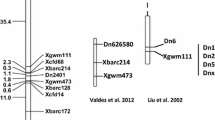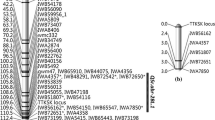Abstract
Tan spot, caused by Pyrenophora tritici-repentis, is an economically important disease in major wheat production areas. The fungus can produce two genetically distinct symptoms on leaves of susceptible wheat genotypes: tan necrosis (nec) and extensive chlorosis (ch1). Our objectives were to determine the number of genes conditioning resistance to tan spot in a population of wheat recombinant inbred lines, and map the chromosomal location of the resistance genes using RFLPs. Conidia produced by the P. tritici-repentis isolate Pti2 (nee + chl +) were used to inoculate seedlings of 135 recombinant inbred lines derived from the cross of the synthetic hexaploid wheat W-7984 with Opata 85. A subset of the population was inoculated with conidia produced by the isolates D308 (nec − chl +) and 86–124 (nec + chl−). Inoculated seedlings were rated on a scale of 1 to 5 based on lesion type. Necrosis-inducing culture filtrate produced by the isolate 86–124 was also used to screen the entire population. A map consisting of 532 markers was employed to identify significant associations between marker loci and tan spot resistance. The entire population was insensitive to culture filtrate produced by the isolate 86–124, and the entire subset was resistant to conidial inoculation of the same isolate. The population segregated for reaction to isolates D308 and Pti2, indicating that this population segregates for resistance to extensive chlorosis only, and not to tan necrosis. RFLP analysis indicated the presence of a gene with a major effect in 1AS, a gene with a minor effect in 4AL, and an interaction between the 1AS gene and a gene in 2DL. Together, these loci explained 49.0% of the variation in this population for resistance to tan spot produced by the isolate Pti2. Two regions one in 1BL and one in 3BL, were significantly associated with resistance to extensive chlorosis, but were not significant in the multiple regression model. It should be feasible to introgress these resistance loci into adapted genetic backgrounds by using a marker-assisted selection scheme.
Similar content being viewed by others
References
Alam KB, Gustafson JP (1988) Tan-spot resistance screening of Aegilops species. Plant Breed 100:112–118
Elias E, Cantrell RG, Hosford RM Jr (1989) Heritability of resistance to tan spot in durum wheat and its association with other agronomic traits. Crop Sci 29: 299–304
Faris JD, Anderson JA, Francl LJ, Jordahl JG (1996) Chromosomal location of a gene conditioning insensitivity in wheat to necrosis-inducing culture filtrate from Pyrenophora tritici-repentis. Phytopathology 86:459–463
Hosford RM Jr (1982) Tan spot. In: Hosford RM Jr (ed) Tan spot and related diseases workshop. North Dakota State Univ Agric Exp Stn Fargo, N.D., pp 1–24
Hosford RM Jr, Jordahl JG, Hammond JJ (1990) Effect of wheat genotype, leaf position, growth stage, fungal isolate, and wet period on tan spot lesions. Plant Dis 74:385–390
Jones SS, Dvorák J, Qualset CO (1990) Linkage relations of Gli-D1, Rg2, and Lr21 on the short arm of chromosome 1D in wheat. Genome 33:937–940
Jones SS, Dvorák J, Knott DR, Qualset CO (1991) Use of double-ditelosomic and normal chromosome-1D recombinant substitution lines to map Sr33 on chromosome arm 1DS in wheat. Genome 34:505–508
Kosambi DD (1944) The estimation of map distances from recombination values. Ann Eugen 12:172–175
Lamari L, Bernier CC (1989a) Toxin of Pyrenophora tritici-repentis: host-specificity, significance in disease, and inheritance of host reaction. Phytopathology 79:740–744
Lamari L, Bernier CC (1989b) Evaluation of wheat for reaction to tan spot (Pyrenophora tritici-repentis) based on lesion type. Can J Plant Pathol 11:49–56
Lamari L, Bernier CC (1991) Genetics of tan necrosis and extensive chlorosis in tan spot of wheat caused by Pyrenophora tritici-repentis. Phytopathology 81:1092–1095
Lamari L, Bernier CC, Smith RB (1991) Wheat genotypes that develop both tan necrosis and extensive chlorosis in response to isolates of Pyrenophora tritici-repentis. Plant Dis 75: 121–122
Lamari L, Bernier CC, Bailance GM (1992) The necrosis-chlorosis model in tan spot of wheat. In: Francl LJ, Krupinsky JM, McMullen MP (eds)Advances in tan spot research. North Dakota State Univ Agric Exp Stn Fargo, N.D., pp 10–15
Lamari L, Sayoud R, Boulif M, Bernier CC (1995) Identification of a new race in Pyrenophora tritici-repentis: implications for the current pathotype classification system. Can J Plant Pathol 17:312–318
Lander ES, Green P, Abrahamson J, Barlow A, Daly MJ, Lincoln SE, Newberg L (1987) MAPMAKER: An interactive computer package for constructing primary genetic linkage maps of experimental and natural populations. Genomics 1:174–181
Lee TS, Gough FJ (1984) Inheritance of septoria leaf blotch (S. tritici) and Pyrenophora tan spot (P. tritici-repentis) resistance in Triticum aestivum cv Carifen 12. Plant Dis 68:848–851
Luz WC da, Hosford RM Jr (1980) Twelve Pyrenophora trichostoma races for virulence to wheat in the central plains of North America. Phytopathology 70:1193–1196
Ma ZQ, Sorrells ME, Tanksley SD (1994) RFLP markers linked to powdery mildew resistance genes Pm1, Pm2, Pm3 and Pm4 in wheat. Genome 37:871–875
Marino CL, Nelson JC, Lu YH, Sorrells ME, Leroy P, Tuleen NA, Lopes CR, Hart GE (1996) Molecular genetic maps of the group-6 chromosomes of hexaploid wheat (Triticum aestivum L. em. Thell.) Genome 39:359–366
McIntosh RA, Hart GE, Gale MD (1994) Catalogue for gene symbols in wheat. 6. Symbols for loci and alleles controlling quantitative characters. Annu Wheat Newslett 40:374
Mehta YR, Gaudencio CA (1991) Effects of tillage practices and crop rotation on the epidemiology of some major wheat diseases. In: Saunders DA (ed) Proc Int Conf on Wheat for Non-tradiational Warmer Areas. CIMMYT, Mexico, pp 226–283
Mehta YR, Riede CR, Campos LAC, Kohli MM (1992) Integrated management of major wheat diseases in Brazil: an example for the southern cone region of Latin America. Crop Protec 11:517–524
Nagle BJ, Frohberg RC, Hosford RM Jr (1982) Inheritence of resistance to tan spot of wheat. In: Hosford RM Jr (ed) Tan spot and related diseases workshop. North Dakota State Univ Agric Exp Stn Fargo, N.D., pp 40–45
Nelson JC, Sorrells ME, Van Deynze AE, Lu YH, Atkinson M, Bernard M, Leroy P, Faris JD, Anderson JA (1995a) Molecular mapping of wheat. Major genes and rearrangements in homoeologous groups 4, 5, and 7. Genetics 141:721–731
Nelson JC, Van Deynze AE, Autrique E, Sorrells ME, Lu YH, Merlino M, Atkinson M, Leroy P (1995b) Molecular mapping of wheat. Homoeologous group 2. Genome 38:516–524
Nelson JC, Van Deynze AE, Autrique E, Sorrells ME, Lu YH, Negre S, Bernard M, Leroy P (1995c) Molecular mapping of wheat. Homoeologous group 3. Genome 38:525–533
Rees RG (1982) Yellow spot, an important problem in the northeastern wheat areas of Australia. In: Hosford RM Jr (ed) Tan spot of wheat and related diseases workshop. North Dakota State Univ Agric Exp Stn Fargo, N.D., pp 68–70
Rees RG, Platz GJ (1983) Effects of yellow spot on wheat: comparison of epidemics at different stages of crop development. Aust J Agric Res 34:39–46
Rees RG, Platz GJ (1990) Sources of resistance to Pyrenophora triticirepentis in bread wheats. Euphytica 45:59–69
Riede CR, Francl LJ, Anderson JA, Jordahl JG, Meinhardt SW (1996) Additional sources of resistance to tan spot of wheat. Crop Sci 36:772–778
SAS Institute (1988) SAS users guide. Statistics. SAS Institute, Cary, North Carolina
Sykes EE, Bernier CC (1991) Qualitative inheritance of tan spot resistance in hexaploid, tetraploid, and diploid wheat. Can J Plant Pathol 13:38–44
Tomás A, Bockus WW (1987) Cultivar-specific toxicity of culture filtrate of Pyrenophora tritici-repentis. Phytopathology 77:1337–1366
Tuori RP, Wopert TJ, Ciufetti LM (1995) Purification and immunological characterization of toxic components from cultures of Pyrenophora tritici-repentis. Mol Plant-Microbe Interact 8:41–48
Van Deynze AE, Dubcovsky J, Gill KS, Nelson JC, Sorrells ME, Dvorák J, Gill BS, Lagudah ES, McCouch SR, Appels R (1995) Molecular-genetic maps for group-1 chromosomes of Triticeae species and their relation to chromosomes in rice and oat. Genome 38:45–59
Wiese MV (1987) Compendium of wheat diseases. American Phytopathological Society, St. Paul, Minnesota
Author information
Authors and Affiliations
Additional information
Communicated by G. E. Hart
Rights and permissions
About this article
Cite this article
Faris, J.D., Anderson, J.A., Francl, L.J. et al. RFLP mapping of resistance to chlorosis induction by Pyrenophora tritici-repentis in wheat. Theoret. Appl. Genetics 94, 98–103 (1997). https://doi.org/10.1007/s001220050387
Received:
Revised:
Issue Date:
DOI: https://doi.org/10.1007/s001220050387




